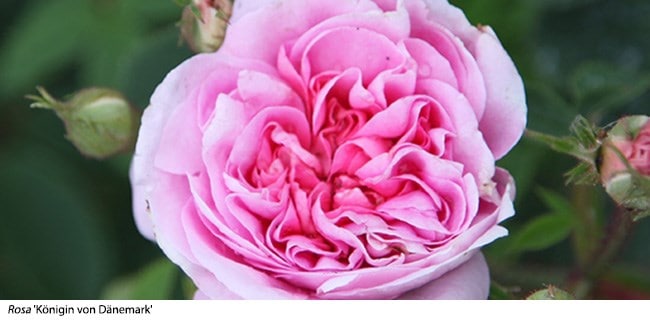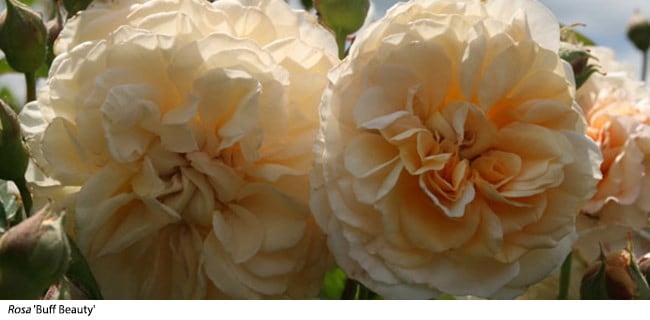Shrubby and healthy
Shrubby and Healthy
 Lots of roses escape black spot (Diplocarpon rosae) and they include Rugosa roses bred from a shrubby Japanese species found naturally on poor, sandy soil. These thrive in most gardens, although lime-rich soil will produce yellow, chlorotic foliage. One of the finest, ‘Roseraie de L'Haÿ’ (1901) was named after a notable French rose garden of the same name. The serrated foliage is a rich-green, darker than most Rugosa, and the almost double purple-pink flowers appear from May onwards, but don’t expect many hips. The semi-double white, ‘Blanche Double de Coubert’, makes an excellent hedge but again there are few red hips. Light pruning in spring is best, because Rugosas tend to get some dieback following cold winters. Shrub roses and English roses are never pruned hard.
Lots of roses escape black spot (Diplocarpon rosae) and they include Rugosa roses bred from a shrubby Japanese species found naturally on poor, sandy soil. These thrive in most gardens, although lime-rich soil will produce yellow, chlorotic foliage. One of the finest, ‘Roseraie de L'Haÿ’ (1901) was named after a notable French rose garden of the same name. The serrated foliage is a rich-green, darker than most Rugosa, and the almost double purple-pink flowers appear from May onwards, but don’t expect many hips. The semi-double white, ‘Blanche Double de Coubert’, makes an excellent hedge but again there are few red hips. Light pruning in spring is best, because Rugosas tend to get some dieback following cold winters. Shrub roses and English roses are never pruned hard.
I think one of the loveliest old-fashioned shrub roses is Rosa 'Königin von Dänemark'. It has the most delicious, fully double, very fragrant, deep to lighter pink flowers in midsummer, with grey-green foliage to offset the blooms. Further more will tolerate some shade and it is known to be disease resistant.

Health and vigour are a quality also found in the Reverend Pemberton’s Hybrid Musks. These roses, bred between 1924 and 1939, are garden classics and they flower well in July and then again in late-summer and autumn. They are all fragrant and healthy. ‘Buff Beauty’ (1939 ) is from the Pemberton stable. It was introduced by Ann Bentall, the widow of Joseph Pemberton’s head gardener. Large trusses of warm-apricot flowers age to sunset-pink against reddish foliage with a gorgeous, tea rose-scent to be enjoyed close to an entrance or seating area if possible ‘Buff Beauty’ adores a warm position and although it takes a few years to get established it’s a show-stopper.

The Hybrid Musks are also trouble-free when it comes to disease and they are tolerant of poorer soil too, possibly because they were bred in the relatively dry county of Essex. David Austin's Rosa William and Catherine ('Ausrapper') is a hybrid musk with an intoxicating myrrh fragrance. The flowers are exquisite, starting with a gentle apricot flush, turning to a cream, then quickly to form white cupped, many petalled blooms. It is has a bushy habit and strong resistance to disease.‘Bonica’, another superb rose for poorer soil, was raised in France by Meilland in 1982. The clusters of bright-pink flowers glow in a border and it’s low-growing and compact, bearing between a dozen to fifteen flowers per cluster throughout summer. This is one rose worth planting en masse, because it’s rarely out of flower so your garden can be full of roses from June onwards.
So don't forget, now is the time to place your rose order!






